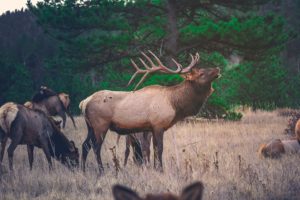
Montana is home to a lot of elk—134,557 to be more precise. Elk reign prominently in our state’s identity and Montana is better for it. Yet, according to the Elk Management Plan put forth by Montana Fish, Wildlife and Parks (FWP), this is 42,419 elk too many.
In a state where hunting reigns, one would think that hunters would make short order of this bounty. Who doesn’t enjoy a freezer brimming with elk steaks? But in spite of the generous number of licenses allocated and extended hunting seasons, hunters have been unable to knock back elk herds to the levels FWP is hoping for. At best, hunters skim off as many elk as young elk are added each year, essentially maintaining the status quo.
Pressured by private landowners and legal mandates to drive elk numbers down, FWP created additional hunting seasons called elk shoulder seasons (ESSs). ESSs occur outside of the traditional archery and firearm seasons in September through November and are designed specifically to harvest cow elk in areas that are above objectives, according to the plan. ESSs begin as early as August and resume December through mid-February
 Many hunters feel hunting elk for up to six months is cruel and that these long seasons require breaking with conventions of hunting elk ethically. FWP has been quick to acknowledge the dilemma it is in—on the one hand, the directive to harvest more elk, and on the other to uphold hunting ethics—and FWP is committed to evaluating the performance of ESSs following the three-year pilot project from 2016-2018 including 43 hunting districts. The results are now in. — Thomas Baumeister
Many hunters feel hunting elk for up to six months is cruel and that these long seasons require breaking with conventions of hunting elk ethically. FWP has been quick to acknowledge the dilemma it is in—on the one hand, the directive to harvest more elk, and on the other to uphold hunting ethics—and FWP is committed to evaluating the performance of ESSs following the three-year pilot project from 2016-2018 including 43 hunting districts. The results are now in. — Thomas Baumeister
The ESSs resulted in a net increase of 4,559 cow elk taken compared to the preceding five years with no ESSs. At first glance, this looks like success. But it’s really just a drop in the bucket and only 10% of what is ultimately needed to reign in elk. At this rate, the statewide elk population goal won’t be reached until 2050.
A closer look reveals that during the ten weeks of general hunting in September through November, hunters harvested 9,852 cow elk, compared to 6,521 cow elk that were taken during the additional ten weeks of ESSs. Given ESSs are designed specifically to harvest cow elk, whereas the regular season is not, and ESSs occur at a time of year when weather conditions tip the odds in favor of hunters, the performance is much lower than anticipated.
Furthermore, ESSs didn’t perform well in the areas where elk are most abundant and problems persist. Instead, they performed better in areas where elk are less abundant and subject to considerable harvest during the regular seasons already. Thus, ESSs did not solve the problem of overpopulation, and in some cases even compounded it by driving entire elk herds to seek refuge on inaccessible private land.
Without access to land where elk live, offering a six-month hunting season might sound impressive but does little to achieve the desired harvest. Elk are crafty and adaptive, seeking refuge in places with fewer hunters. The largest concentrations of elk occur on private land, especially in central Montana in FWP Regions 4 and 5, which are comprised of large ranches, often with little or no public hunting access. In other Regions, ESSs have seen some degree of success and hunter-landowner advisory committees have worked with FWP to carefully craft regulations to meet those area’s specific needs and challenges.
Statistically speaking, if 1,000 elk hunters hunt during the regular five-week rifle season in October/November, only about 200 take an elk; 80% go home empty-handed. These statistics are not as much a reflection of skill but rather of access (or lack thereof). FWP’s goal of harvesting thousands of elk would require a massive army of elk hunters on the Montana landscape for weeks on end coupled with generous access to private land – something that we haven’t achieved yet. Solving the elk dilemma requires a different approach and perspective.
We know what is not working. But we don’t yet know what will work. At best, the data indicate that without additional opportunities to access elk herds on private land, public hunting will remain largely ineffective in spite of generous hunting seasons and elk licenses. We need a diversity of users to come together to think creatively about solutions that recognize the intricate web of private property rights, public elk, elk behavior, hunting traditions and effectiveness, and other interrelated factors.
This is about more than just sound elk management; it’s about how we relate to and treat elk. Not only are ESSs ineffective and viewed by some as unethical, they are also emblematic of a larger societal trend whereby, in the face of a faltering ability to manage, a once revered species is being relegated to vermin. What does this say about us?
It’s time to dig deep and think outside of the box.
If you have ideas, please let FWP and the FWP Commission know. They’d like to hear from you: http://fwp.mt.gov/hunting/publicComments/2019
By Thomas Baumeister in conjunction with his 2019 Community Scholar Fellowship with Merlin CCC.

This op-ed by Thomas Baumeister about the practical and moral challenges of elk shoulder seasons was picked up by four papers spanning the state of Montana: Helena Independent Record, Bozeman Daily Chronicle, the Missoulian, and Butte Standard.
